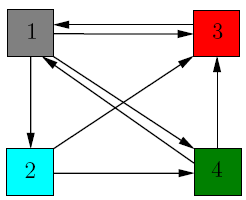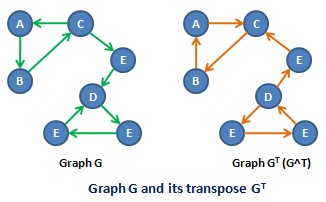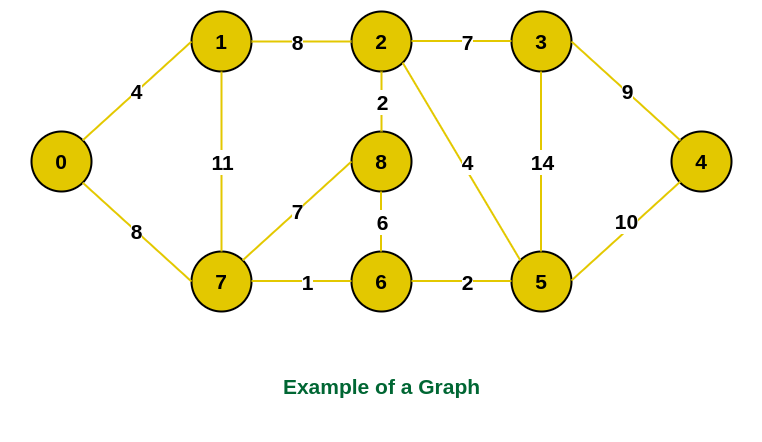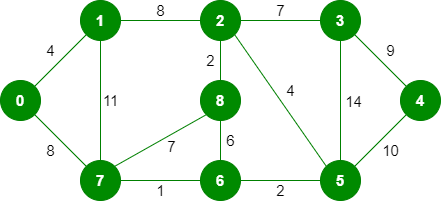Chapter 4: Graphs
Graphs19:14
Definition (Graph)
An undirected graph is a set G=V×E where
E⊂{{v,w}:v,w∈V}Remarks
- The elements of V are called vertices
- The elements of E are called edges
- If instead E⊂{(v,w):v,w∈V}, the graph is called directed
Adjacency matrix19:14
Definition (Adjacency matrix)
Assume V={1,…,n}
aij={10if there’s an edge from itojotherwiseRandom browsing19:14
- Each page has the same probability of being the start page
- There is at most one link from one page to any other
- On each page, each link has the same probability of being clicked
- If there are no links, the next page can be any page with equal probability

Ranking webpages19:14
- Xk: k-th page visited
- P(Xk=i): probability that the k-th page is page i
Idea
If k is small, P(Xk=i) depends too much on X0. A good way to measure the popularity of page i would be
pi=defk→+∞limP(Xk=i)Rank and PageRank19:14
Definition (PageRank vector)
Transition Matrix19:14

Properties of the transition matrix19:14
Proposition
Corollary
The PageRank vector satisfies
p(∞)=Tp(∞)Weakness of naive PageRank19:14


Question
What's the issue with the above graphs? How would you fix it?
PageRank algorithm19:14
Idea
Approximate p(∞)≈p(k) for some large k via
p(k+1)=Tp(k)Exercise
Implement it on this dataset
Show the ten highest ranked pages.
PageRank: solution19:14
Graph Exploration19:14
Question
From a given set of nodes, which vertices can I reach?
- Web crawling
- Social networking
- Network Broadcast
- Garbage collection
Adjacency list19:14
Definition (Adjacency list)
Question
How much space does that representation required?
Θ(V+E)
Adjacency list/matrix19:14
Breadth-first search19:14
- Visit all the nodes reachable from a given node s∈V
- We want to achieve O(V+E) time
- Look at nodes reachable in 0,1,2,… moves
- Careful to avoid duplicates (otherwise running time could be infinite)
Breadth-First Search19:14
Exercise
Write an algorithm that perform breadth-first search from a given source node s.
Shortest paths19:14
Exercise (Shortest paths)
Change the BFS algorithm so that you can keep track of a shortest path from s to any node.
Running Time19:14
Proposition
Depth-first search19:14
- Recursively explore graph, backtracking as necessary
- Careful not to repeat
Exercise
Implement DFS, when you're given the set of vertices and an adjacency list.
DFS: Running time19:14
Proposition
The Running time of DFS is Θ(V+E)
Exercise: Sudoku solving19:14
Exercise (Sudoku Solving)
Sudoku is a puzzle where you're given a 9 by 9 grid partially filled with digits. The objective is to fill the grid subject to the constraint that every row, column, and box (3 by 3 subgrid) must contain all of the digits from 1 to 9.
Exercise: N queens problem19:14
Recall: DFS19:14
- Recursively explore graph, backtracking as necessary
- Careful not to repeat
Sudoku: solution19:14
Edge classification19:14
- Tree edge: visit new vertex via edge
- Forward edge: node to descendant in a tree but not a tree edge
- Backward edge: node to ancestor in tree, indicate a cycle
- Cross edge: between two non-ancestor related vertices
Question
How can we know what type of edge (u,v) is?
- Tree edges: v is white when we explore edge
- Forward edge: v is black when we explore edge
- Back edge: v is gray when we explore edge
- Cross edge: v is black when we explore edge
Edge classification in undirected graphs19:14
Proposition
In an undirected graph, every edge is either a tree or a backedge.
Corollary
An undirected graph is acyclic if and only if there are no back edges
Acyclic directed graphs19:14
Proposition
A directed graph is acyclic if and only if there are no back edges.
Topological Sort19:14
Problem
Given a directed acyclic graph, "sort" the vertices in such a way that the edges are always pointing to the right.
Applications include:
- Building software
- Job scheduling
- Select courses with prerequisites
Topological sort: example19:14

Topological sort: algorithm and proof of correctness19:14
- Run DFS
- Output vertices in decreasing order of finish time
Proposition
If (u,v)∈E, then
u.f≥v.fTopological sort: implementation19:14
Exercise
Modify DFS to implement topological sort
Exercices19:14
Strongly Connected Component19:14
Definition (Strongly connected component)
Let G=(V,E) be a directed graph. A subset C⊂V is a strongly connected component if for every pair u,v∈C, there is a path from u to v and from v to u.
Definition (Component graph)
Let G=(V,E) be a directed graph with connected connected C1,…,Cn. The component graph is the graph
{Ci:1≤i≤n}×{(Ci,Cj):1≤i,j≤n and there’s a path between Ci and Cj}Strongly connected components19:14
Problem
Given a directed graph G, find its connected components
Remark
- DFS-Visit will always visit at least the connected component of the starting point, but might visit other connected components too.
- Between two strongly connected components, there's a one-way bridge between them.
Transpose graph19:14
Definition (Transpose graph)
Let G=(V,E) be a graph. Its transpose graph is the graph
V×{(v,u):(u,v)∈E}
Question
Why is it called the transpose graph? What happens to the adjacency matrix when we transpose the graph?
Exercise
Write a Python code that transforms a graph (given via an adjacency list) to its transpose.
Strongly connected components: algorithm19:14
- Topological sort the edges of the graphs
- Transpose the graph
- Run DFS visit on unvisited nodes in the order given in Step I.
Exercise
Implement it
Strongly connected components: proof of correctness19:14
Proposition
Assume that S1,…,Sn are the strongly connected components of a graph G=(V,E) in the order given by the SCC algorithm.
If s∈Si, then DFS-Visit will only reach the vertices in S1,…,Si in the transpose of G.
Corollary
The SSC algorithm is correct.
Weighted graph19:14
Definition
A graph G=(V,E) is weighted if it's given with a function w:E→R.

Minimum spanning tree19:14
Problem
Given an undirected weighted and connected graph ((V,E),w), find a spanning subtree T⊂E with smallest total weight.

Edge contraction19:14
Definition (Edge contraction)
G/e: Remove edge and merge the vertices it previously joined
Question
What did we do about common neighbours?
Dynamic programming solution19:14
- Guess edge e in a MST
- Contract e
- Recurse
- Decontract e and add e to MST
Remark (Greedy)
We will remove the guessing part by proving that the greedy choice is optimal
Question
What's the time complexity?
Correctness of the DP algorithm19:14
Proposition
Assume e belongs to some MST T∗ of G. If T′ is a MST of G/e, then T′∪{e} is a MST of G
Sketch proof
w(T′∪{e})=w(T′)+w(e)≤w(T∗∖{e})+w(e)=w(T∗)Definitions19:14
- Cut: partition of the vertices in two sets (S,V∖S)
- Edge (u,v) crosses cut S if u∈S,v∈V∖S or vice-versa.
- Cut respects A if no edge in A crosses the cut.
- light edge crossing a cut: minimal weight of any edge entering the cut.
Criterion for safe edge19:14
The greedy choice works.
Proposition
Assume A⊂E is a subset of some MST.
If S is a cut respecting A and (u,v) is a light edge crossing (S,V∖S), then (u,v) is also part of some MST.
We've reduced guessing an edge to using a particular cut respecting A.
Greedy Generic MST algorithm19:14
A = {}
while A is not spanning:
find safe edge e
A.add(e)
return AWe'll see: Prims, Kruskal
Prim's Algorithm: Idea19:14
- Start at vertex s
- Cut will be the visited vertices
- Maintain a priority queue containing crossing edges. Prioritize lighter edges.
Example
Find the MST of the following graph

Prim's Algorithm: Python implementation19:14
Question
How would we get the tree itself?
Prim: Time complexity19:14
Proposition
The time complexity of this algorithm is O((V+E)logV)
Kruskal's algorithm19:14

Union-Find structure19:14
Idea
Keep track of connected components
We'll need two operations to apply Kruskal
- Union: unites two components
- Find: finds an element's component
Union-Find structure: Python implementation19:14
Kruskal's implementation19:14
Kruskal: correctness19:14
Proposition (Kruskal: correctness)
Kruskal's algorithm returns an MST.
Question (Time complexity)
What is the time complexity?